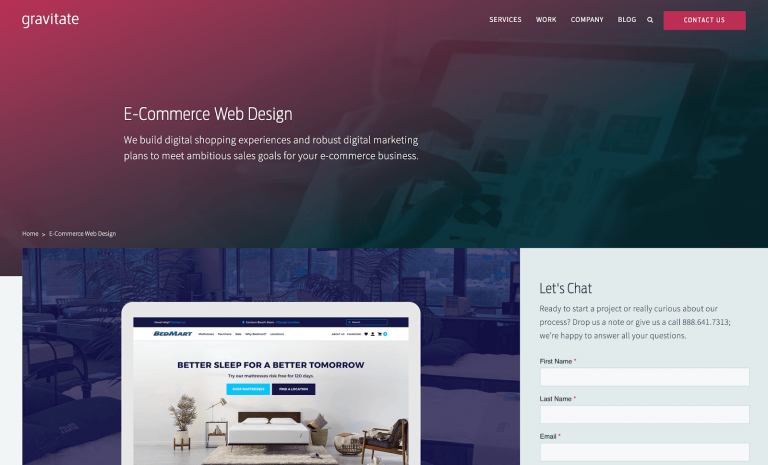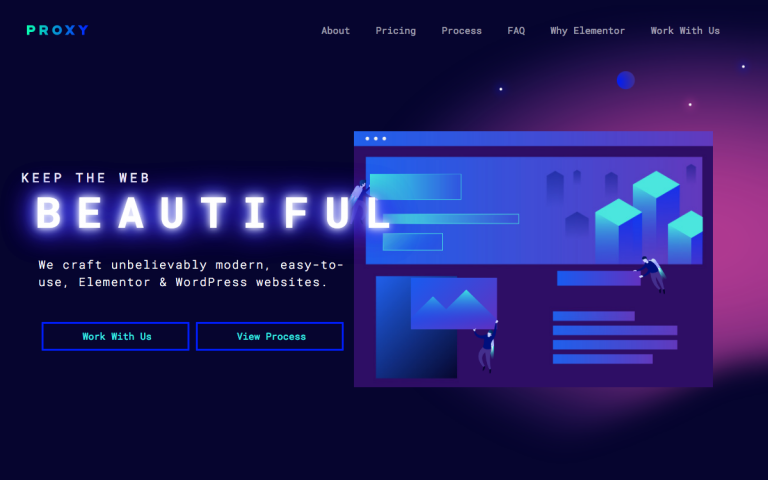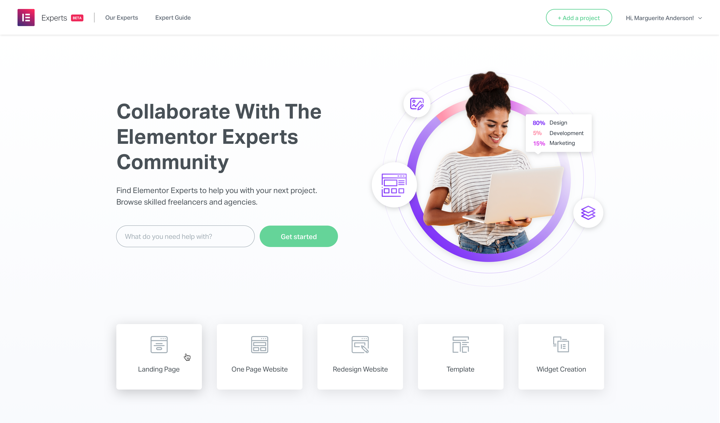Table of Contents
Standing out from competitors and keeping your work schedule full are goals many web designers can relate to. Making smart business decisions to ensure your services’ sustainability will go a long way towards helping you accomplish them. Choosing a web design niche is one such decision.
Specializing can seem counter-intuitive. You want to expand your client base, and narrowing your scope might appear to go against that. However, focusing on one niche can have several advantages, including increased productivity and profitability.
In this article, we’ll discuss why you need to niche down as a web designer and how to do so. We’ll also cover some popular specializations and pitfalls to avoid when choosing yours even before starting your web design business . Let’s get started!
Table of Contents
- What Is a Web Design Niche?
- Why You Need a Web Design Niche
- Profitable Web Design Niches
- How to Find Your Web Design Niche
- 1. Pick a Niche Based on Past Projects
- 2. Look Into Current Web Design Trends
- 3. Check Out Your Competition
- 4. Consider Your Hobbies and Interests
- 5. Do Your Research Before You Niche Down By Industry
- 6. Learn Your Target Audience’s Pain Points
- What to Avoid When Choosing a Web Design Niche
- Stand Out by Specializing in a Web Design Niche
What Is a Web Design Niche?
A “niche” is defined as a specialized segment of the market for a particular kind of product or service. When a service provides ‘niches’ down their offerings, they’ve chosen to focus on one particular area or business within their broader industry.
In web design, this refers to choosing to offer design services to specific audiences, business types, or websites. For example, a web designer could choose to specialize in ecommerce websites, non-profit organizations, etc.
Alternatively, a web design niche could refer to a specific feature, such as redesigns, rebranding, or web accessibility.
Why You Need a Web Design Niche
According to the U.S. Bureau of Labor Statistics, the number of jobs available for web developers is expected to increase by 13 percent by 2028 – more than any other occupation. Growth in online purchasing, expansion of ecommerce, and heightened mobile device usage, all contribute to an elevated demand for these services.
This certainly spells a bright outlook for the industry. However, getting new clients will be no less challenging. Specializing in a particular web design niche can help you in this area, due to a variety of factors.
Some key advantages of niching down include:
- Expertise in your industry – Being able to discuss the latest trends of your clients’ industry can cement you as a knowledgeable professional in their eyes. You can demonstrate that you’re uniquely fit to solve their problems and keep up with their evolving demands. This means you’re also able to charge more for your services as a recognized expert.
- Increased productivity – You typically want to spend the bulk of your time on actual design work, not figuring out your clients’ wants and needs. Learning the ins and outs of a particular industry will enable you to anticipate and prevent potential problems. This can lead to fewer revisions, less time spent overall to achieve your final product, and happier clients. Additionally, you’ll likely start to build up a library of prebuilt elements and templates that will help streamline your work.
- More effective marketing – When you focus on a particular area of web design, your website copy and sales pitch tend to become more specific and personalized. People understand immediately what you do, who your audience is, and how you can help them solve their problems.
Together, these benefits ultimately mean more revenue for you as you take on more clients and higher-quality projects.
An Introduction to Profitable Web Design Niches
Deciding to specialize in a particular web design niche is fairly simple. Choosing which specific area to focus on is much harder. We’ll provide some tips on how to determine the right industry for you shortly, but first, let’s look at some popular options on the market right now.
One route some web designers take is to work with those in a particular profession. You might specialize in creating websites for lawyers, or dentists, or pizza parlors. While this is a smart move for all the reasons we discussed above, it may also feel limiting, since the work can become repetitive:

An alternative is to design a specific type of website, such as ecommerce sites. Considering the growth in online sales we mentioned earlier, this is likely to be a high-demand and profitable niche in the coming years:

Although you’ll work on many of the same features – product pages, payment processing, etc. – you’ll still be able to enjoy some variety. You might work on one site that sells dog toys, another that sells software, and so on. This way you’ll be able to use your problem-solving skills to whip up unique solutions for your clients.
Another option is to niche down by platform or Content Management System (CMS). You can specialize in designing WordPress sites, for example, and take advantage of tools such as website builders to speed up production:

The last niche we’ll mention here is local or regional web design. This involves specializing in sites for small businesses or other location-specific clients. It generally requires in-depth knowledge of your city or town, and the ability to translate relevant details into the site’s design.
In short, the possibilities are near endless. You can also combine multiple niches (for example, WordPress Elementor site building) to narrow your scope further.
How to Find Your Web Design Niche (6 Key Tips)
It can take some effort and time to settle on a web design niche, even if you already have an idea of which one you might want to pursue. Fortunately, we’ve put together some tips to make the decision easier.
1. Pick a Niche Based on Past Projects
One of the easiest ways to choose a niche is to look back at the projects you’ve already done. You may already be starting to specialize in a particular type of site without even realizing it.
However, if your portfolio truly is eclectic, and there are no noticeable patterns in the projects you take on, it can still help you narrow down the right niche for you. Take a look at some of the past work you most enjoyed or are most proud of, and consider whether you could focus on creating similar websites for new clients.
You can also look into which projects paid the best. While money isn’t the sole factor to consider when choosing a niche, it certainly helps to know that there’s a market that’s willing to pay well for the type of work you’re offering.
Of course, this assumes you’ve already worked on some web design projects. If that’s not the case, another option is to take on some entry-level or pro bono work to try out different niches and determine what might be the best fit for you.
Consider reaching out to NGOs and charitable organizations. These clients typically have very small budgets but also need nonprofit websites in order to accomplish their own goals.
An advantage of picking a niche you’ve already worked in is that you know something of the demand that exists for designers in that area, as well as how feasible it might be to work in financially. Plus, past clients can provide referrals and other networking opportunities to help you find leads.
2. Look Into Current Web Design Trends
Trends can come in handy when you’re deciding on a niche. For example, you can market your services to target established businesses or startups that are interested in implementing new business practices or emerging technologies.
This brings us to another type of niche web design service we didn’t mention earlier – redesigning websites. You can pitch updates to leads with outdated online content and make this your area of expertise.
Recent web design trends can also point out areas that might be experiencing an increase in profitability. For example, 2020 has seen a surge of interest in web accessibility.
This could mean that schools, government agencies, and other organizations that could face serious fines for non-compliance with accessibility laws are on the lookout for web designers who specialize in this area. That’s your chance to step up and address their needs.
You can extend this concept to many other web design trends, too. Plus, staying on top of industry news is always wise. It enhances your credibility and enables you to create sites that will produce the results clients want to see.
3. Check Out Your Competition and Determine If There’s an Existing Market
You might really want to specialize in making websites for ice cream shops. However, you’re going to run into trouble if there aren’t enough clients in this niche for you to find enough work to make a living.
This is where market research comes in. You’ll need to do some digging to determine whether your desired niche is viable, or if you need to rethink your strategy.
Some key questions to ask yourself when you’re getting started with this process include:
- Is there a sizable client base available for this type of work?
- How competitive is this niche?
- How much are other web designers charging for this type of work?
The best place to start looking for the answers to these questions is freelance marketplaces. You can pretty quickly see how many people are hiring designers to do certain jobs on platforms such as Upwork, Fiverr, and for Elementor users — Elementor’s Experts Network:

You can also see how much they’re asking for their services and how saturated the market is. While this obviously isn’t comprehensive data, it should still give you an idea of where things stand in a particular niche.
Other potentially fruitful research opportunities include looking at small agency prices and conducting come classic Google searches. If you type “ice cream web design” into the search bar and nothing relevant comes up, it may not be a profitable avenue to take.
4. Consider Your Hobbies and Interests
While profitability is certainly important, it isn’t everything. As we briefly mentioned earlier, one of the drawbacks of niching down is that your job can become somewhat repetitive and boring. That’s why it’s important to choose a specialty that aligns with your interests.
Selecting a niche that excites you will make it easier to stay curious and explore more deeply its problems, unique features, and trends. Consider making a list of hobbies or interests you’re extremely passionate about and finding out what existing web design related to those areas looks like.
For example, you can Google “gaming website design” or, if you’re a foodie, “restaurant website design.” You might be pleasantly surprised by the ways in which you can bring together your career and your passions.
Additionally, your interest in the field will give you a unique perspective that can help set you apart from other designers. If leads feel like you’re as invested in their website as they are, they may feel more inclined to hire you.
5. Do Your Research Before You Niche Down By Industry
Focusing on an industry is arguably the easiest way to niche down. However, while it might be tempting to jump right in and start marketing to high-end clients such as doctors and lawyers, the smart approach is to do your research first.
Websites in a particular industry typically feature many of the same common elements. Knowing what those are for the niche you’re hoping to appeal to is vital for a few reasons.
For starters, it’s a matter of establishing your credibility. You don’t want to receive your first call from a potential client who’s looking for a medical site and have to tell them you don’t know how to create an appointment booking system.
Secondly, knowing the standards of web design for your potential niche is important for client satisfaction. Leaving off a key component could lead to problems down the road for the site’s owner, resulting in revisions and/or poor reviews.
Plus, if you’re learning how to create a new type of website on the fly, it’s going to take more time. That means a longer wait and a higher bill for your clients, both of which aren’t likely to make them particularly happy.
Fortunately, the solution here is simple. Start by looking through examples of sites in the niche you want to target. Take notes on similarities between them, as well as any features you think are especially helpful and elevate the website.
Then, read up on web design best practices related to those features. In addition to increasing your knowledge and expertise, this will also give you an idea of the time commitment creating sites in this niche will require, which in turn will help with pricing your services and other key decisions.
6. Learn Your Target Audience’s Pain Points
Rather than niching down just by industry, you can get even more specific by focusing on singular problems within a field. This strategy also lends itself well to specialization in redesigns or other unique services.
Once again, this strategy requires you to do some research into your prospective niche. In most cases, a few Google searches will likely turn up the most prevalent challenges faced by the particular target audience you have in mind.
You can then take the information you find and shape your services around it. For example, more sales are happening on mobile devices these days. As a result, you may consider specializing in responsive ecommerce design.
What to Avoid When Choosing a Web Design Niche
There are a few pitfalls to avoid when making a choice of web design niche, some of which we’ve already addressed informally. Firstly, while you do need to pick a niche that can hold your interest long-term, doing so might not be practical if your desired specialty is really obscure.
Remember that at the end of the day, you’re building a business. Your choice of web design niche should strike a balance between what you find interesting and what pays well enough to cover your bills.
On the flip side, you don’t want to work on projects you’ll grow bored with, or with groups whose values do not align with yours. This is a fast track to burnout, which will quickly undo all the benefits of niching down in the first place.
Additionally, you’ll want to ensure you’ve done enough research on your potential clients before you begin marketing your services to them. This includes everything from their culture and audience to their businesses’ pain points.
For example, some design elements may be culturally inappropriate for certain regions. Even though your clients might not tell you all the features you’ll need to avoid or use sparingly in their projects, extensive research on your part should make you aware of them.
We previously noted that choosing a niche may increase your client referrals and networking opportunities. However, this doesn’t mean you don’t need to engage in both short and long-term marketing strategies to promote your business.
You’ll want to be intentional about establishing yourself as an expert. This should be reflected in every channel you use for marketing your services, whether it’s your website, authority content pieces, or social media ads.
Stand Out by Specializing in a Web Design Niche
Finding your web design niche can be challenging, especially due to the number of possible options available to you. However, specializing your services this way can be rewarding. You may be able to stand out from competitors more effectively and drum up more business by establishing your expertise.
We’ve discussed several potential niches you could focus on, as well as tips for determining which one is right for you. Some of those include picking a niche based on your past projects, considering your hobbies and interests, and researching your audience’s pain points.
Do you have any questions about finding your web design niche? Let us know in the comments section below!
Looking for fresh content?
By entering your email, you agree to receive Elementor emails, including marketing emails,
and agree to our Terms & Conditions and Privacy Policy.






